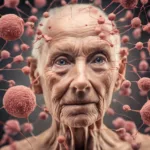27 December 2023
Understanding the Markers and Functions of Mid-Old Cells in Aging
As the human body ages, the cells within it undergo a complex process of senescence, leading to various age-related diseases and physiological changes. However, the specific characteristics and functions of mid-old cells, an intermediate stage between young and old cells, have remained largely unknown. In a groundbreaking study, researchers have utilized an in vitro culture model to identify the markers and characteristics of mid-old cells, shedding light on their role in the aging process. This research not only deepens our understanding of cellular aging but also offers potential strategies for reversing the aging phenotype.
Identifying Mid-Old Cells and Senescence Markers
In their study, the researchers utilized primary human fibroblasts and sub-cultured them in increasing passages to observe the changes in cell morphology, proliferation, and the expression of senescence markers. They categorized the sub-cultured fibroblasts into three groups: young, mid-old, and old cells based on doubling time and SA-β-Gal positivity. The researchers found that mid-old cells exhibited distinct gene expression patterns, including p53-p21Waf1-dependent cell cycle inhibition, which was confirmed through RNA-sequencing. These mid-old cells were more closely related to young cells than old cells, indicating that they possess unique characteristics that distinguish them from both young and old cells.
Functional Changes in Mid-Old Cells
To investigate the functional changes in fibroblasts during the aging process, the researchers conducted gene set enrichment analysis (GSEA) using hallmark gene sets. They found that mid-old cells showed a clear senescence phenotype only in old cells, while young and mid-old cells exhibited functional indices related to self-replication, extracellular matrix formation, tissue organization/regeneration, and immune response regulation. Interestingly, mid-old cells showed an upregulation of the IL1β pathway, suggesting a specific inflammatory response in these cells. Additionally, mid-old cells exhibited increased expression of genes related to peptide metabolism, indicating a potential upregulation of protein metabolism in mid-old cells.
Presence of Mid-Old Cells in Elderly Tissues
To validate the presence of mid-old cells in vivo, the researchers performed immunohistochemistry (IHC) analysis on elderly tissues using mid-old cell markers identified in their in vitro studies. They found that stromal cells in elderly tissues, such as the colon and lung, exhibited increased expression of mid-old-specific inflammatory genes, including IL1β and SAA1. These findings suggest that mid-old cells contribute to the development of an aging-related microenvironment characterized by chronic inflammation. Furthermore, the researchers observed a downregulation of anti-inflammatory factors, such as SLIT2 and CXCL12, in elderly tissues, indicating a shift towards a pro-inflammatory state.
Functional Role of SAA1 in Elderly Tissues
The researchers investigated the functional role of SAA1, a mid-old-specific inflammatory gene, in elderly tissues. They found that SAA1 upregulation in fibroblasts and smooth muscle cells led to increased expression of matrix metalloproteinases (MMPs), which are involved in the degradation of extracellular matrix components. This suggests that SAA1 may contribute to the deterioration of tissue structure and function in aged organs. Additionally, SAA1 downregulated the expression of muscle contraction-related genes, leading to muscle atrophy. The researchers also observed a decrease in type IV collagen, a major component of the basement membrane, in elderly tissues, potentially due to its degradation by MMP9. These findings suggest that SAA1-mediated degradation of the extracellular matrix and basement membrane may contribute to the functional decline of aged organs.
Reversal of Aging Phenotype by Young Cells and SLIT2
The researchers explored the potential of young cells to reverse the aging phenotype of mid-old cells. They co-cultured mid-old cells with young cells and found that the proliferative ability of mid-old cells significantly increased. RNA-sequencing analysis revealed that co-cultured mid-old cells exhibited functional recovery in various criteria, including self-replication, extracellular matrix production, tissue regeneration, and inflammation regulation. The researchers identified several factors released from young cells, including Lnc-RNA-SBLC and SLIT2, which contributed to the reversal of the aging phenotype in mid-old cells. Treatment with recombinant SLIT2 protein resulted in decreased expression of inflammatory genes and proteins, restoration of cell morphology, and increased proliferative capacity of mid-old cells. Furthermore, downregulation of SLIT2 in young cells induced the expression of inflammatory genes and decreased cell proliferation, confirming the role of SLIT2 as an anti-aging factor.
Anti-Aging Effects of SLIT2 in Aged Mice
To validate the anti-aging effects of SLIT2 in vivo, the researchers treated aged mice with recombinant mouse SLIT2 protein. They observed increased activity and decreased levels of the inflammatory marker SAA1 in the blood of treated mice. Necropsy results showed inhibition of muscle mass reduction and decreased numbers of p21Waf1-positive mid-old cells in various organs of treated mice. These findings suggest that SLIT2 has the potential to reverse the aging phenotype in aged mice.
Conclusion:
The study provides valuable insights into the characteristics and functions of mid-old cells, shedding light on the complex process of cellular aging. The identification of mid-old cell markers, such as SAA1 and SLIT2, offers potential strategies for reversing the aging phenotype and improving tissue function in aged individuals. Further research is needed to fully understand the mechanisms underlying the anti-aging effects of young cells and SLIT2, paving the way for the development of novel interventions to combat age-related diseases and improve overall health in the elderly.



